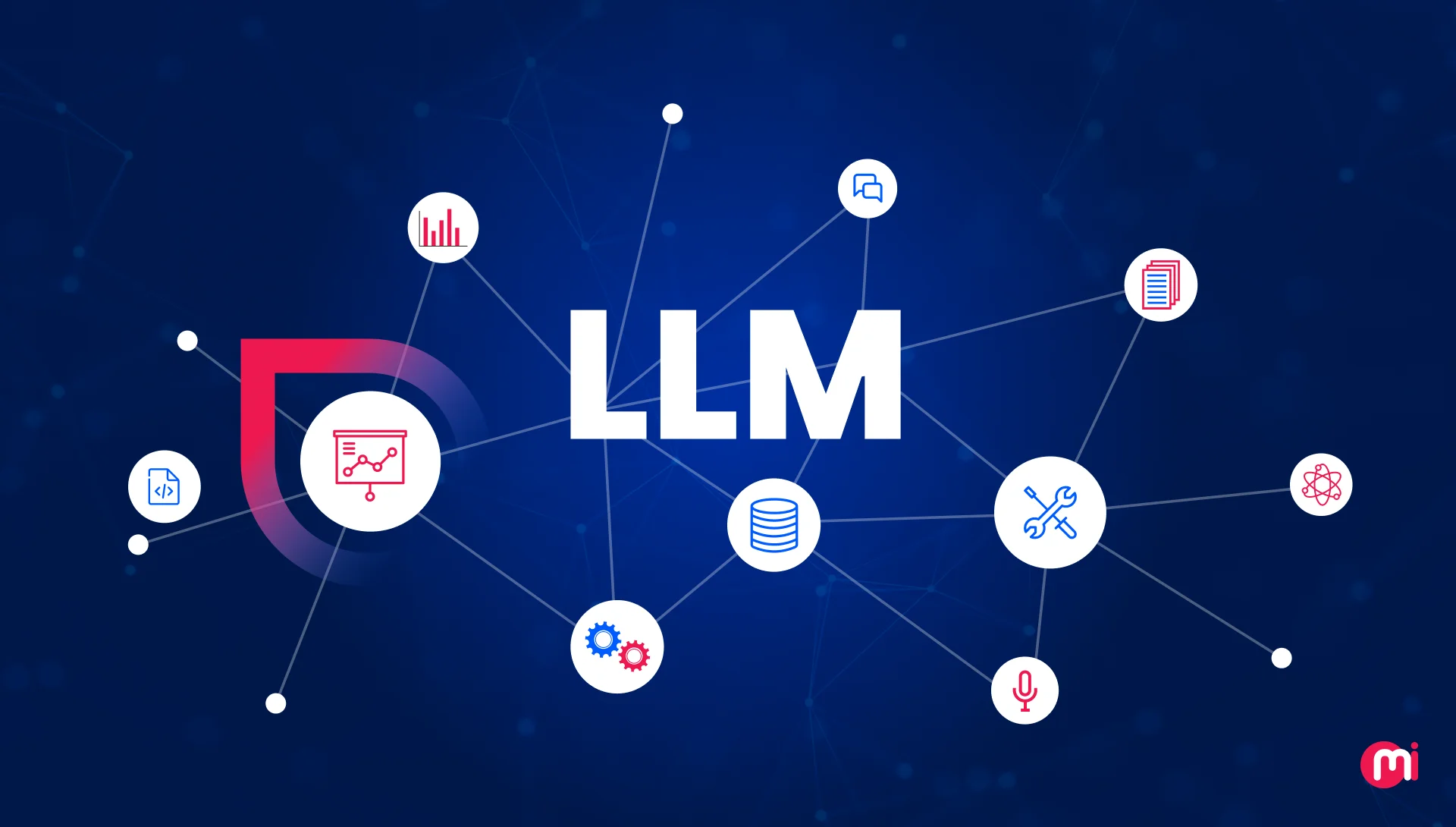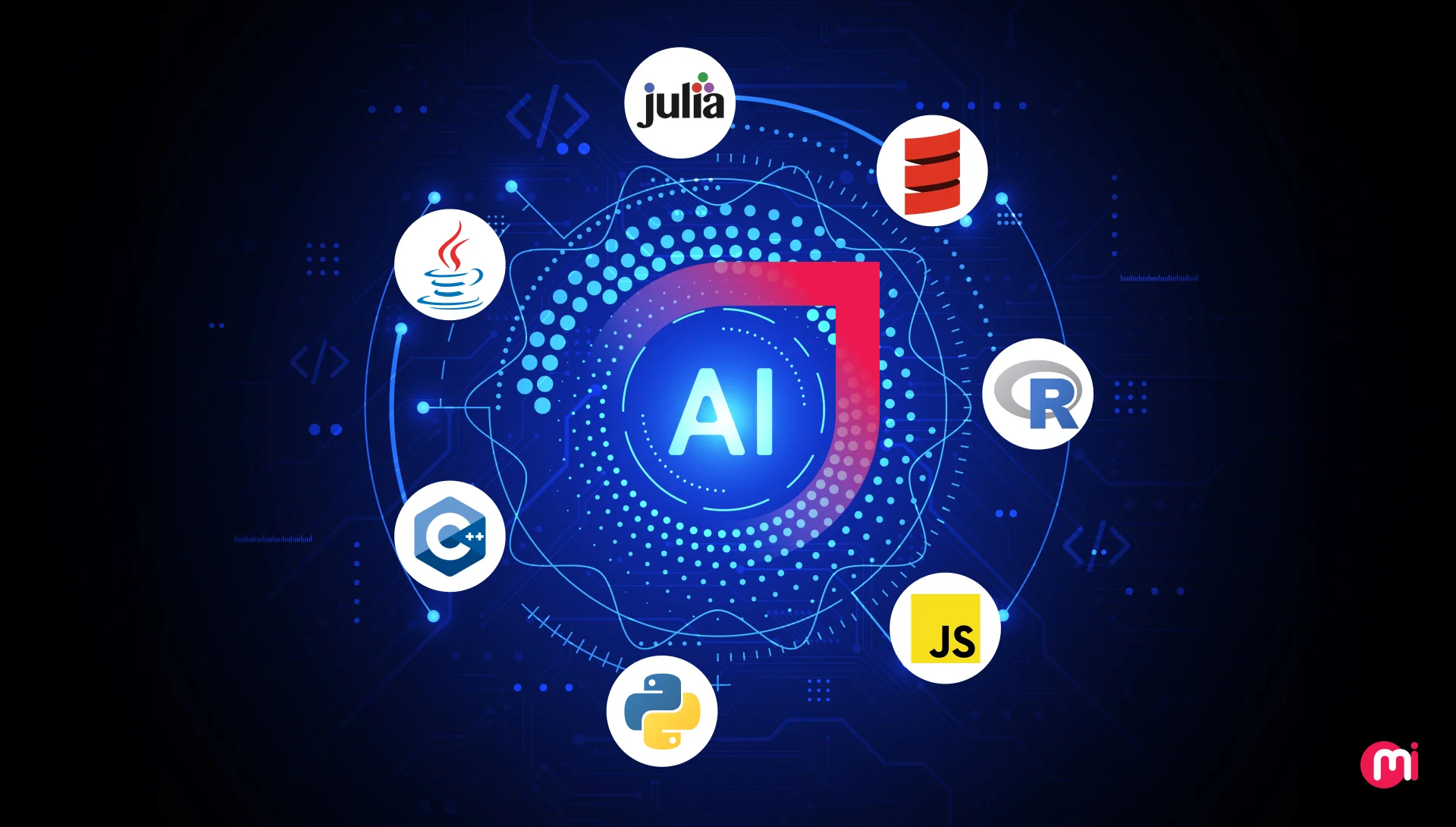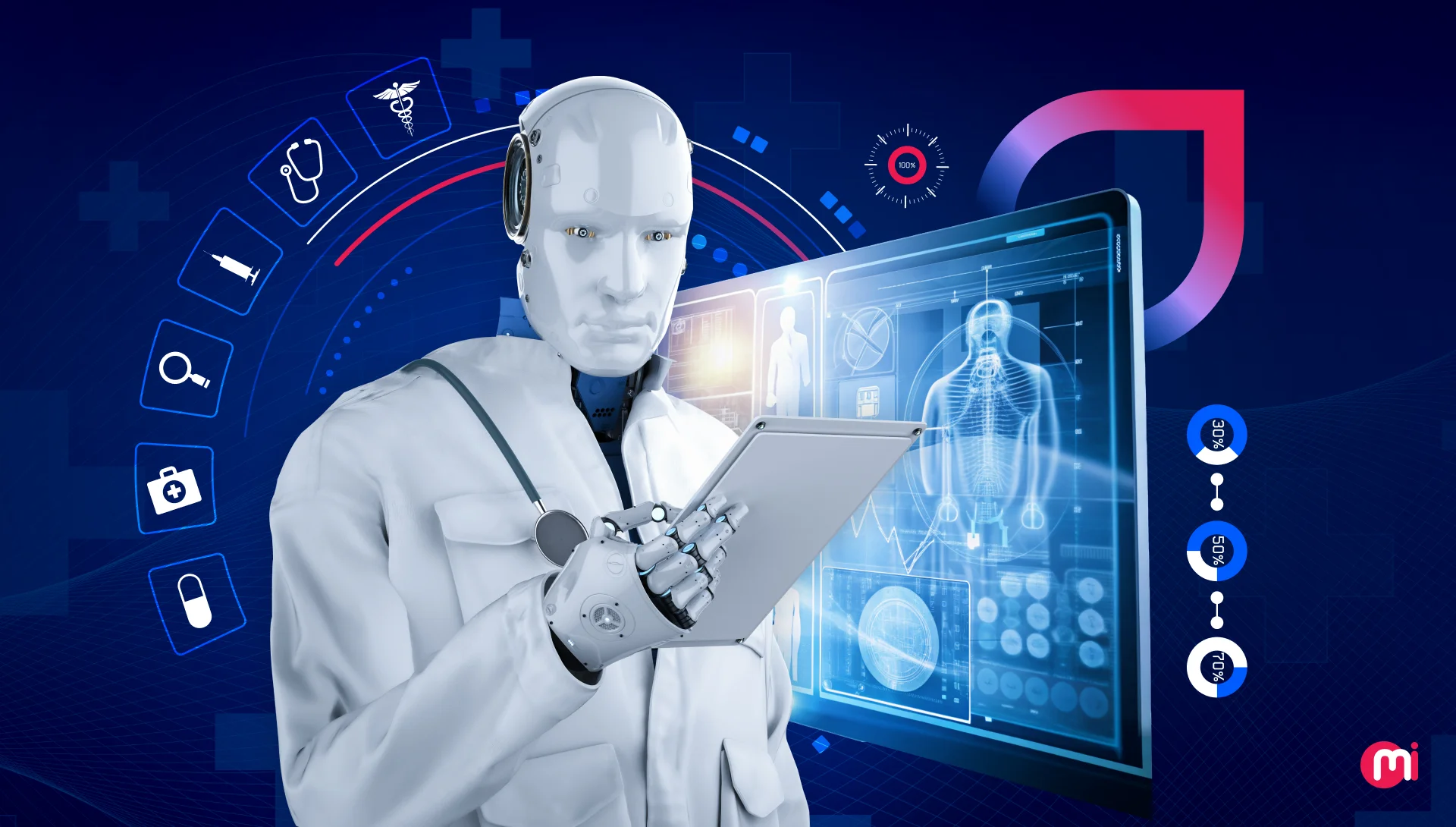AI Statistics: Trends, Risks, and Future Predictions (2025 Updated)
- AI/ML
- March 30, 2025
Artificial Intelligence (AI) is redefining and disrupting the way we handle various tasks, from shopping and search experiences to customer support and beyond. Check out this blog on artificial intelligence statistics for 2025, which covers the impact AI has made and will continue to make in the future, along with predictions.
AI is projected to add $15.7 trillion to the global economy by 2030, but 74% of companies still struggle to achieve and scale value with AI adoption, says PwC.
However, 2025 has become the pivotal year for AI growth, as more trends like Agentic AI, AI agents, multimodal AI, and more have emerged.
Enterprises have also started to step up in Generative AI maturity 5 levels: level 1 dedicated to exploration, level 2 for experimentation, level 3 for implementation, level 4 for integration, and level 5 for transformation.
With that trend, evolving into agentic AI, around 82% of enterprises plan to invest in agentic AI (SeoClarity). Plus, agentic AI is expected to automate at least 15% of day-to-day work decisions by 2028.
Along with more and more AI trends emerging, there are also debates going around about AI being ethical or not. As per the Santa Clara University survey, 68% of respondents show their concern about the AI’s negative impact on the human race. Hence, 67% of organizations also prioritize AI ethics to outperform their peers in sustainability, social responsibility, and diversity and inclusion (IBM).
So, there’s just more to discuss about artificial intelligence trends and growth in current dynamics across industries. This blog on statistics about artificial intelligence is all about that. So, let’s dive in.
Top 10 AI Statistics for 2025-2031
Let’s have a look at our top picks on current AI adoption statistics to quickly help you make further decisions:
- The global market size of Artificial Intelligence is projected to grow to $1.01 trillion by 2031 at a CAGR of 26.60% (2025-2031).
- A McKinsey survey revealed that 90% of Fortune 500 companies plan to employ OpenAI’s tech to embrace AI innovation.
- As per Cisco’s survey, 83% of executives think AI is a top priority in their business plans today, and 75% find AI as their gateway to shift into new businesses and ventures.
- The US AI market is forecast to reach $309.70 billion by 2031, with the AI market expanding at a CAGR of 26.95% from 2025 to 2031. (Statista)
- 75% of generative AI users are using it to automate their tasks and communications, while 38% are using it for fun and 34% are finding it as an easy gateway to learn about topics. (Salesforce)
- Companies that have successfully fully integrated AI into their operations have achieved 20–30% productivity gains, speed to market, and revenue. (PwC)
- In the category of artificial intelligence growth statistics, Gartner says around 33% of enterprise software applications will be built with agentic AI by 2028.
- 82% of enterprises plan to invest in agentic AI. This also adds on Agentic AI to automate at least 15% of day-to-day work decisions by 2028. (Seoprofy)
- Grand View Research says the global market of multimodal AI market size is poised to hit $93.99 billion by 2035 at a CAGR of 39.81%.
- According to statistics about AI agents, 39% of consumers vote for getting comfortable with AI agents handling their customer service appointments. (Salesforce)
But how are these AI agents and Agentic AI different? Check out our expert comparison of AI agents vs. Agentic AI to innovate their business procedures.
Statistics for AI: Investments and Futuristic Contributions
Let’s have a look at the artificial intelligence growth statistics and know how AI will automate business in the future:
- A weforum report says 41% of experts show affirmative beliefs on AI automation to replace old jobs with new roles.
- The AI chips market is expected to be worth $44.3 billion in 2025, increasing to $127.8 billion by 2028. (Exploding Topics)
- Out of 25 attributes tested across organizations of all sizes that have adopted AI, they have seen considerable EBIT impact from the use of gen AI. (McKinsey)
- Funding for the AI-related companies. If we see, only the U.S.-based businesses have done $471 billion of AI investment as compared to $289 billion done by the rest of the countries globally. (Visual Capitalist)
- In Climate AI research, Capgemini estimates that AI can contribute to a 16% reduction in GHG emissions and a 15% increase in power efficiency in the following couple of years.
- A recent study by Alteryx suggests that by 2030, up to 34% of AI and machine learning development jobs could be transformed or absorbed by even more advanced AI assistants.
- The World Economic Forum (Jan 2025) projects that by 2030, AI and related tech will generate 170 million new roles worldwide but displace 92 million jobs, for a net gain of 78 million (≈7% of current jobs).
- Globally, 86% of companies expect that by 2030, AI adoption will transform their businesses entirely. (Workera)
- By 2027, AI’s energy demands could reach 85–134 TWh, accounting for nearly 0.5% of global electricity usage. (DownToEarth)
Latest Generative AI Statistics
After the commencement of advanced AI tools like ChatGPT, Deepseek, Claude, Grok, Gemini, etc. Generative AI solutions have become a necessity in today’s corporations. Now, every business wants to invest in Generative AI development services to fuel their productivity and better work experience.
Generative AI Market Size
- In banking, this technology can help to generate revenue of $200 billion to $340 billion annually if fully implemented correctly. (McKinsey)
- In retail and FMCG, it can help to generate revenue of USD 57.7 billion by 2033 at a CAGR of 22%, says a market report. It will be in the FMCG areas of product development and marketing and advertisement, customer experience, supply chain optimization, package design, and manufacturing. (Market US)
- The overall generative AI market is expected to grow by leaps and bounds to $375.2 billion by 2031, which is a rise of +560.92% from 2025 to 2031. (Statista)
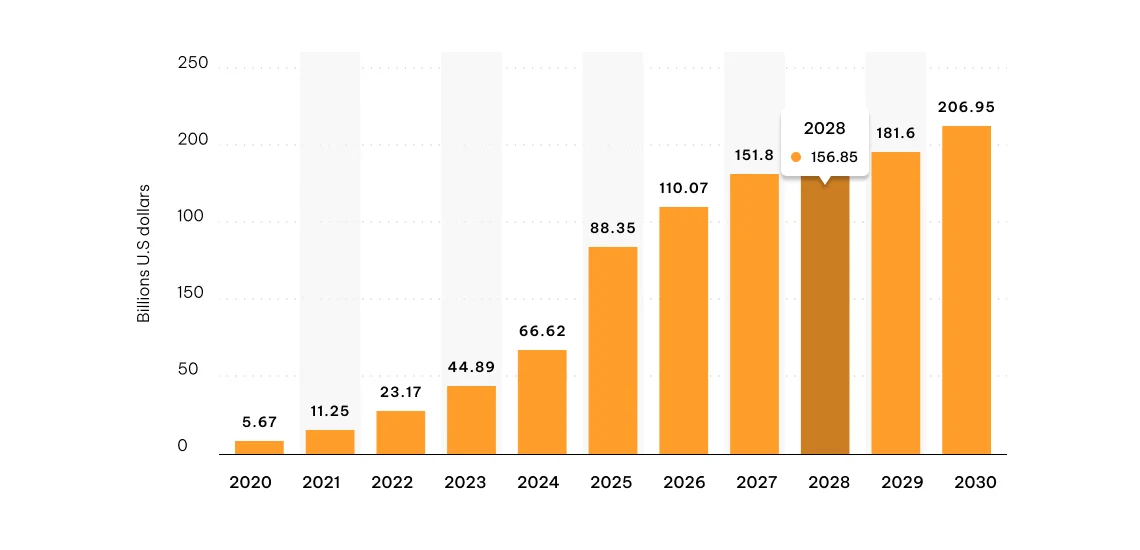
Gen AI User Stats
- If you check for the Generative AI users, the majority, 65% are Millennials or Gen Z, among whom 72% are employees. (Salesforce)
- It doesn’t end with that – among those, 70% of Gen Z are using it extremely, and 52% even found trusting this technology provides useful information for making informed decisions.
- Want to get some information from Generative AI about any topic? Then, the prompt is the answer. Speaking of which, 6 out of 10 people confidently say that they are on to mastering the use of this technology to the fullest extent.
- If considering the usage of Generative AI across countries, then India leads the way with 73% of the population using this technology, followed by 49% of the Australian population, 45% of the US population, and 29% of the UK population.
Gen AI Use Case Statistics
Generative AI in application development is not only related to advanced chat applications; it has more applications than this. Some of the popular use cases of Generative AI include:
- With AI, automation is the aspect we all want, and hence, 75% of users use Generative AI to automate their tasks at work and even for work communications.
- While 38% of Generative AI find it as a platform to have fun or mess around, 34% find learning opportunities for topics they are interested in.
- In the segment of gen AI in healthcare, in Q4 2024, 85% of respondents (including healthcare leaders from payers, health systems, and healthcare services and technology (HST) groups) have successfully adopted gen AI capabilities. (McKinsey)
- If talking about marketing experts, then around 73% of them use Generative AI tools to produce content. (Capgemini)
- When Botco surveyed 1000 marketing professionals, they discovered 55% excessively use ChatGPT and 42% use Copy.AI, 36% use Jasper.AI, 25% use DALL-E, 24% use MidJourney, etc.
- In the talk about software development, around 95% are found using AI to generate code and fix code bugs to create software applications. (SourceGraph)
Generative AI Ability AND Impact
- One McKinsey survey revealed that Generative AI has the potential to boost the impact of AI by 15-40%.
- Combining Generative AI with other cutting-edge technologies may potentially add productivity growth annually by 0.5 to 3.4% with work automation. (McKinsey)
- 67% of marketing professionals find Generative AI helpful for enhanced content creation processes, as it has the potential to decrease their workload by nearly 60%. (Capgemini)
- Generative AI and content creation are the things we are confident about for this technology, and around 82% of marketing professionals also show their affirmation that AI-powered content creation is as effective as human-produced ones. (Capgemini)
Indeed, Generative AI is shaping the future of content creation, code generation, media generation, polishing, and becoming a personal AI assistant.
Statistics about AI Trends Emerging In 2025 And Beyond
When looking at AI technology trends, in the past 6 months, there has been a dramatic shift from generative AI to more evolved versions of it, known as agentic AI, AI agents, and more. Let’s check out statistics about AI trends:
Agentic AI
Agentic AI is a type of AI that empowers systems that leverage large language models (LLMs) and complex reasoning to act autonomously to make decisions and perform tasks without human intervention.
- The global Agentic AI is projected to grow to $196.6 billion by 2034 at a CAGR of 43.8% (2024-2034). In 2024, the US Agentic AI market size was last valued at $1.58 billion at a CAGR of 43.6%. (Market US)
- As per Gartner, 33% of enterprise applications will be seen integrated with Agentic AI.
- It also mentions the use of Agentic AI in customer services will resolve more than 80% of issues without human intervention, leading to a 30% reduction in operational costs by 2029.
- Manufacturing and logistics industry businesses leveraging Agentic AI in operations experience 30% higher operational efficiency gains and a 40% reduction in processing times. (DigitalDefynd)
- Implementing agentic AI has been linked to a 30% increase in employee satisfaction, as it automates mundane tasks, allowing employees to focus on more strategic activities. (Salesforce)
- As per InsightAce Analytics, the global contribution of Agentic AI in the healthcare market is projected to hit $21.1 billion by 2034 at a CAGR of 46.1% for the forecast period 2025-2034.
- As per Maximize Market Research, the global Agentic AI in real estate market is expected to reach $1,803.45 billion by 2030 at a CAGR of 35%.
Looking to make the most of your investment in Agentic AI development services? MindInventory can help!
AI Agents
AI agents are the programmed, autonomous agents in the digital world that mimic human agents to complete assigned tasks on behalf of them without any manual intervention. They are best used in customer support channels and as business copilots. If you check the list of the best AI agents for businesses, then Salesforce Einstein, HubSpot’s Breeze, and many others win the trust of enterprises.
Let’s check the market overview and top statistics about AI agents and how businesses share their perspective about it:
- As per the Markets and Markets study, the global AI agent market size is projected to rise to $52.62 billion by 2030 at a CAGR of 46.3% (2025-2030).
- AI agents can help to increase productivity by 55% and reduce costs for companies by 35%. (BNNBloomBerg)
- 82% of organizations are planning to integrate AI agents into their workflows within 1-3 years. (Capgemini)
- Salesforce says that 90% of global constituents are planning to integrate AI agents in their digital ecosystem, allowing them to engage with their government.
- It also predicts the potential application of AI agents in education processes, helping students with school processes (77% vote for it), timely and accurate responses (60%), and administrations (83%).
- AI agents are reshaping the online shopping experience. 24% of consumers vote affirmatively for AI doing shopping, while 32% of Gen Z are using AI assistance for shopping.
Multimodal AI
As the name suggests, Multimodal AI is a type of artificial intelligence built with neural architecture that can support various types of data (including text, images, audio, and video) for various use cases. Top examples of multimodal AI in action include self-driving cars, medical AI identifying and suggesting personalized treatment plans, customer service bots, and more.
- As per global market insights, the global forecast for multimodal AI is estimated to grow to $27 billion by 2034 at a CAGR of 32.7% for the forecast period 2025-2034.
- Approximately 70% of enterprises are exploring or implementing multimodal AI solutions to enhance decision-making and operational efficiency. (Deloitte)
- One Gartner survey mentions, by 2027, around 40% of Generative AI solutions will have a multimodal AI base.
Check out our AI development services to know how we can help to develop advanced solutions harnessing the power of data and AI.
Computer Vision
From OCR to human detection with annotations, computer vision has wider applications across industries and is benefiting businesses in various ways. Let’s check out the artificial intelligence statistics for its application called computer vision that might interest you.
- The global computer vision market is projected to reach $25.80 billion in 2024 and is estimated to reach a staggering $72.66 billion by 2031 at a CAGR of 15.96%. (Statista)
- The segment of PC-based computer vision systems secured the largest market share of 61.7%. , with revenue of $7.2 billion in 2021. (Spherical Insights)
- Speaking about computer vision for the quality assurance and inspection segment, it has also acquired a market share of 17.3% with a revenue of $2.02 billion.
- If talking about the sector adopting computer vision, then retail has been a major adopter of it. One Viso shows that around 64% of retailers are deploying computer vision solutions for better inventory management, and this adoption will grow in the next few years.
- Studies have shown that computer vision algorithms can outperform humans in specific tasks. There’s one DeepMind AI program called AlphaFold, which has achieved 95% accuracy in protein structure prediction, a task previously challenging for human scientists.
Speaking of computer vision in bio and food science, we also have implemented one computer vision-based Nutrition AI – powered by Passio.AI that allows users to scan their food portions and get insights on the nutrition they are about to consume.
- According to IBM, 77% of manufacturers consider computer vision to be a critical technology for achieving their business objectives.
- Speaking about the role of computer vision in traffic management, cities with more traffic often find it difficult to maintain traffic regulations. Considering that researchers used technologies and models like vehicular cloud computing (VCC) + IoT-aided robotic (IoRT) + two deep learning techniques based on modified LeNet-5 for real-time traffic sign recognition + computer vision and created a solution which was tested Extended German Traffic Sign Recognition Benchmark (EGTSRB) and achieved the accuracy of 99.12-99.78% and outperformed traffic sign recognition by 3.78% and traffic light detection and recognition by 1.02%. (Science Direct)
- In medical science, traditionally, analyzing imaging and classifying tumors can take up to 40 minutes. Thankfully, the involvement of AI/ML technologies and integration with MRI images can help to get the results within a few minutes. One study reveals that one AI-powered solution using computer vision with MRI-scanned images can help to analyze and classify brain tumors with 98.56% of accuracy.
Planning to build your computer vision solution customized to your specific use case? Reach out to us now!
Virtual Assistance
Virtual assistants are the new customer executives or agents. These agents use NLP and machine learning to interact with users, found in various devices like smartphones and chatbots. They streamline tasks, boost productivity, and offer personalized assistance. Understanding proven statistics is crucial for successful implementation in business applications, ensuring improved user experience and product/service success.
As per Business Research Insights, at a global level, the intelligent virtual assistant market size is expected to grow to 23.57 million by 2033 at a CAGR of 22.3% for the forecast period 2025-2033.
When we think of Virtual Assistants, we think of Siri, Alexa, Bixby, Google VA, etc. But do you know which virtual/voice assistant is more popular among users? If looking from different country perspectives, then virtual assistant usage is as mentioned below:
- In the US: Alexa is used by 34%, Siri by 27%, and Google Assistant by 31%.
- In the UK: Alexa has usage of around 46%, Siri 26%, and Google Assistant 24%.
- In Germany: Alexa with 31% usage, Siri with 19%, and Google Assistant with 22% usage.
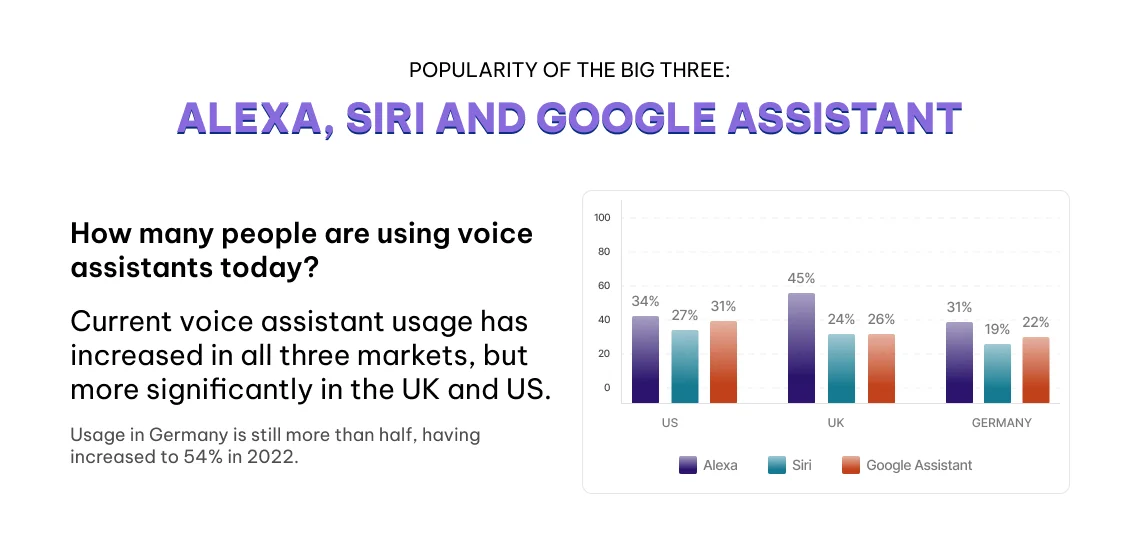
If speaking about using such virtual assistants, then one survey reveals that around ⅗ of people (61.4%) use this type of AI application for personal work, while ⅓ of people (28.9%) use it for their professional work purposes. (AI PRM)
If targeting to implement virtual assistants in your products, then you should consider the below statistics to find your target audience:
- As per the IDAP research, around 97% of mobile users use AI-powered voice assistants for their personal and professional reasons.
- 62% of Americans use voice assistants to search for something, and of them, 35% are using it to access their media from smart speakers. (NPR)
- Around 21% of users use voice assistants as a part of their weekly habits.
- Around 14% of users between the ages of 41 and 60 years old use virtual assistants weekly.
- Around 25.3% of users between the ages of 18-25 years old use virtual assistants weekly.
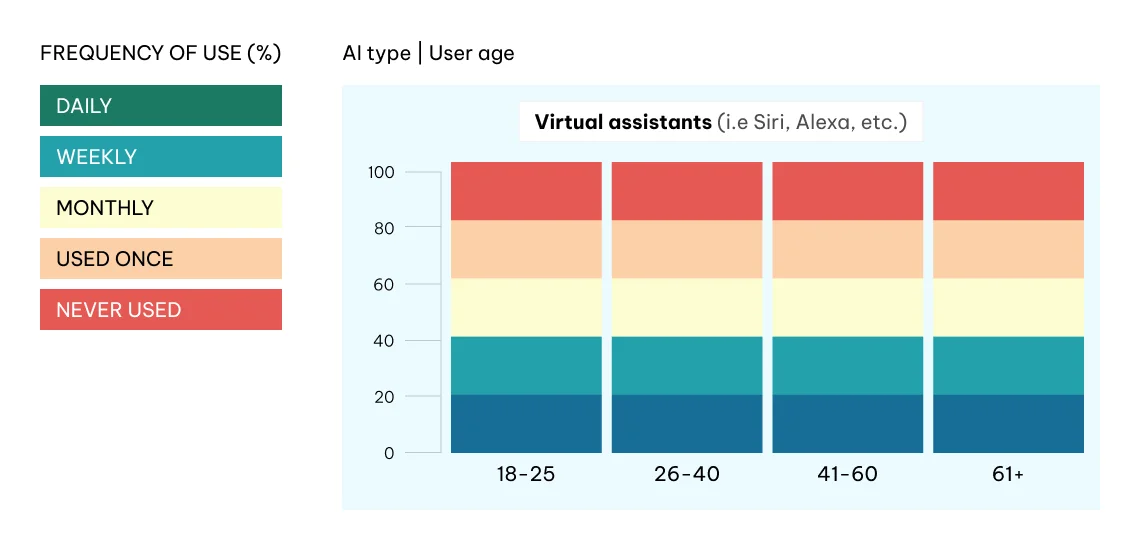
One Statista survey reveals that by 2024, there will be 8.4 billion units supporting digital voice assistants, which is a greater number than the total population of the world.

If speaking about voice assistants used from different devices, then Alexa tops the charts in the category of smart speakers among other voice assistant search platforms, as mentioned in the below image:
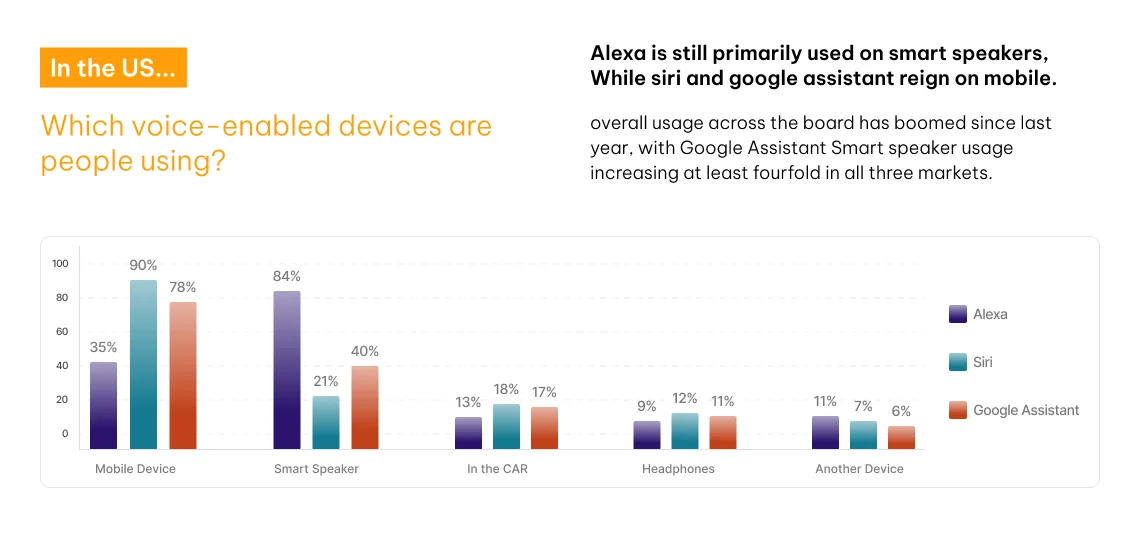
One report reveals that around 54% of users have shown their affirmation that digital assistants will make their lives easier than typing the whole prompt to get the results.
These AI statistics about virtual assistants can help you make your decision about integrating this virtual assistant into your product, like it helped our clients AirAsia and I.AM.+.
Recommendation Systems
Businesses running ad campaigns target users based on their search behavior, showing ads across platforms. This personalized advertising, seen on search engines and apps, is powered by AI, like Netflix predicting viewer preferences and Spotify auto-playing songs based on individual music tastes.
As per AlliedViewResearch, the global recommendation engine market size is expected to reach $43.8 billion by 2031 at a CAGR of 32.1%.
Recommendation Engine Usage and Adoption
AI recommendation engines are widely used in various domains, including e-commerce, media and entertainment, social media, healthcare, financial services, and travel and hospitality
On average, 12% of customers’ overall purchases are attributed to AI recommendations.
Revenue Impact
- When used AI in Retail in the form of recommendation systems, it accounts for up to 31% of e-commerce revenues, with an average of 12% of customers’ overall purchases attributed to them. (barilliance)
- A McKinsey report also states that personalization can contribute to around 10%–15% of the boost in sales conversion and winning the loyalty of customers.
- If the recommendation engine is implemented strategically, it has the potential to increase order rate by 150%, overall site conversion by 13%, and lower business website bounce rate by 24%—achieved by Algolia.
- You’d be amazed to know that around 80% of Netflix users watch movies and shows as suggested by its recommendation algorithms. This is the reason why this trend of binge-watching has given rise to the Netflix and Chill era. Netflix also claims that its algorithmically generated recommendations influence 80% of its viewership, contributing to a revenue generation of 10.2 billion U.S. dollars as of the latest (2024 fourth quarter) (Statista).
So, when creating your Netflix-like OTT app, you must consider adding a recommendation engine as its promotional feature.
After Netflix, another giant in the media and entertainment world is Spotify, which makes the most use of AI, especially its application – Recommendation engine.
In short, recommendation engines are like loyalty-boosting and revenue-driving factors that you must add to your e-commerce app, on-demand services-based app, and other apps where users should get personalized services.
Planning to fuel your recommendation engine to provide more accurate recommendations? Check out our data engineering services for better results.
Cybersecurity
With AI pushing its limits, hackers are getting smart with expanding their usage of AI for their ulterior motives to breach systems that could benefit them. Hence, it’s a must to integrate AI into your cybersecurity practices to outsmart these hackers. Below are the statistics about artificial intelligence (AI) in cybersecurity you must know:
- If we talk about the AI in cybersecurity market size, then experts have forecasted its growth to around $134 billion in 2030 from $24 billion marked in 2023.
- Around 69% of enterprises find AI a necessity to be implemented for cybersecurity standards, considering the increasing number of threats cybersecurity analysts may need to tackle. (WiFi Talents)
- Companies with AI cybersecurity in place have reportedly found savings of up to $3.05 million in cost savings by avoiding data breaches. (IBM)

Industry-Specific AI Usage Statistics
Let’s check out the impact of AI across industries with statistics that your business may find useful:
AI In Healthcare Statistics
When it’s the case about using AI in healthcare, we have many expectations with this technology. Plus, the evolution of AI applications has raised the bar to a different level. Let’s check out some of the popular artificial intelligence growth statistics in the healthcare domain:
- As per MRFR, the healthcare AI market is poised to reach $120 billion by 2035 at a CAGR of 26.2% for the forecast period 2025-2035.
- OTTEHR reports indicate that over 43% of healthcare leaders are benefiting from AI for in-hospital patient monitoring use cases.
- 85% of healthcare organizations are making plan for AI investments.
- One Microsoft-IDC study revealed that around 79% of healthcare organizations currently have AI solutions in place and achieved an ROI of around $3.20 per $1 spent in AI.
- In various AI trends, voice AI is gaining better popularity in healthcare, with market size expected to grow to $21.67 billion by 2032 at 19.9% of CAGR (2025-2032). (Polaris Market Research)
- As per NurseJournal, around 30% of nursing administrative tasks can be done with the help of AI to devote some more time to better patient care.
- As per the HIMSS report, 52% of respondents agree with AI improving healthcare diagnosis, while 32% support better procedural accuracy and 31% support it can help to free up some time to focus on patient care.
AI In Banking, Finance, and Insurance Statistics
When it comes to finding better digital transformation in banking, why should this BFSI sector be left behind? AI in Finance has enabled this sector with many compelling solutions that may transform the way this sector is working. So, let’s explore some of the best AI in Banking statistics that you may find helpful.
- As per Polaris Market Research, the AI in Banking market size is projected to reach $236.70 billion by 2032 at a CAGR of 31.7% for the forecast period 2025-2032.
- In the year 2024, the financial sector invested around $45 billion in AI, which was a substantial increase from the 2023 investment of around $35 billion. (Statista)
- Salesforce surveyed that around 10% of customers completely trust AI agents, while 44% somewhat trust financial businesses using AI agents in operations.
- AI has the potential to automate around 20% of banking and financial activities, as revealed in the Wifitalent report.

AI in Retail & Ecommerce Statistics
Let’s explore some of the latest Artificial Intelligence statistics revealed from the retail & e-commerce use cases:
- As per Coherent Market Research, the AI in retail market is poised to be a $97.83 billion industry by 2032 and will grow at a CAGR of 32% for the forecast period 2025-2032.
- Market Research mentions in its report that the AI in ecommerce market is expected to surpass $50.98 billion by 2033 at a CAGR of 24.3%.
- By 2030, Agentic AI will have a 15-20% stake in the total AI spending for the retail operation transformation.
- The AI-powered inventory management market is on a rapid rise, growing from $7.38 billion in 2024 to $9.6 billion in 2025 at a CAGR of 30.1%. This momentum is set to continue, with the market projected to hit $27.23 billion by 2029, expanding at a CAGR of 29.8%.
- 80% of retail and e-commerce businesses have in place or plan to use AI bots with chatbots. (Businessdit)
- When it comes to shopping online, 86% of shoppers find AI-driven personalization to have a considerable impact on their shopping decisions. (Infosys)
Not just that, AI significantly helps retail businesses to optimize their inventory management and supply chain operations.
AI in Real Estate Statistics
Falling back in the digital transformation race amidst the evolution of AI across industries, Real Estate has been the most curious industry. It is paving the way for AI-enabled digital transformation. Some of the best-known trends and statistics around adopting AI in real estate operations include:
- As per the Scoop Market Study, the global market size of adopting or investing in AI for real estate operations is expected to grow to 41.5 billion by 2033 at a CAGR of 30.5%.
- As per Deloitte, around 70% of real estate companies are making plans to adopt AI in some form.
- Real estate companies that use AI in operations have seen a significant 50% increase in lead generation and 45% in conversion rates.
- In the PropTech segment of the real estate market, the investment in AI-powered solutions is estimated to grow at a CAGR of 11.9%, marking the market size at $89.93 billion by 2032.
- 67% of real estate firms employ AI for property valuations, with AI-based price prediction models achieving up to 90% accuracy.
AI in Sports Statistics
Whether in the form of getting data insights to further create game strategies, like in big sports like car racing (like Formula 1), football, cricket, and more, or automating stadium surveillance through computer vision-powered cameras, AI in sports is getting implemented in various ways.
Let’s check out top AI usage statistics in the sports industry:
- As per Market Research Future, the AI in sports market size is expected to reach $27.87 billion by 2032 at a CAGR of 25.39%.
- Approximately 70% of sports teams worldwide utilize AI technologies to analyze player performance, enhancing training and game strategies. (gitnux)
- The implementation of AI in injury prevention has led to a 20% decrease in sports-related injuries in professional leagues, improving athlete longevity and performance.
- AI-powered fan engagement platforms experienced a 40% increase in usage during major tournaments in 2023, indicating a trend likely to continue in 2025 and beyond.
- AI-based analytics tools in sports broadcasting have improved viewer retention rates by 30%, enhancing the overall viewing experience.
Want to make the most of your data to fuel AI to help you make better decisions for your sports team? Leverage our data & analytics services.
The Impact of AI on the Job Market
The rise of Generative AI has also given rise to new job opportunities, known as Prompt Engineering, which has considerably created many job opportunities, along with job insecurities for many. Let’s take a look at statistics about artificial intelligence showing the impact it can have on the job market:
- As per the report of the World Economic Forum, AI will create 75 million jobs globally and create 133 million new job roles and opportunities.
- There’s one more prediction about the evolution of AI, which is that by 2030, AI can potentially replace 800 million jobs globally. (SEO AI)
- One Bloomberg report shares that over 120 million workers are expected to undergo retraining in the next three years as AI reshapes industry demands.
- Seeing the disruption AI is creating, there are mixed feelings (Negative + Positive) about AI, especially for the job market. Around 53% of people think AI has the potential to spread misinformation about things. (ipsos)
- Taking that further, many think that around 43% of white-collar jobs and 46% of blue-collar jobs will be negatively impacted by AI.
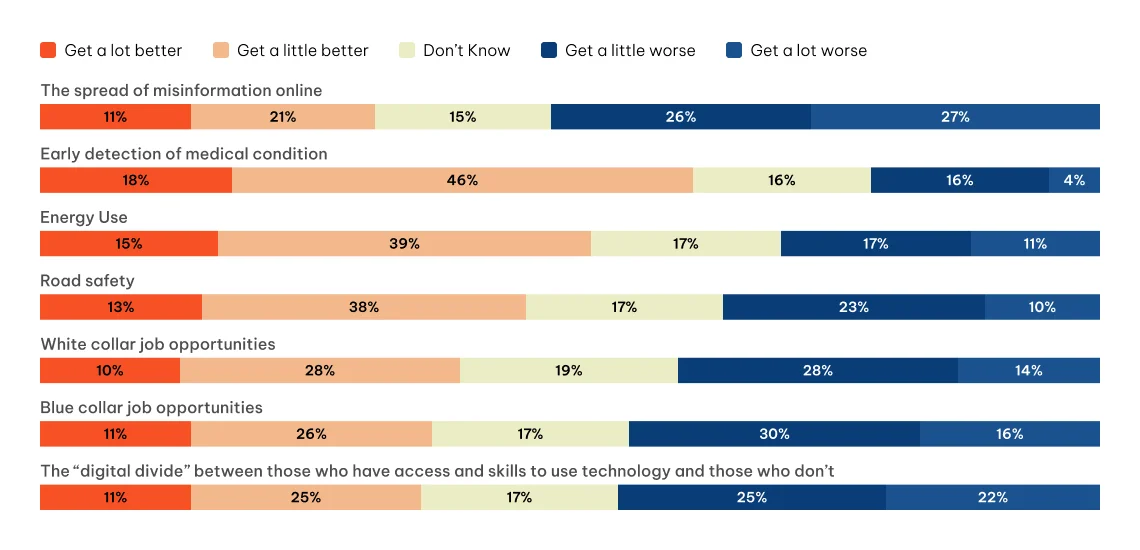
Potential AI Challenges and Predictions
With finding opportunities across domains, it’s also important to know AI statistics about potential challenges it could bring along with some of the power predictions about it raising concerns for businesses.
- When AI is there in the network, security concerns will also be there. As per Mitre’s survey, around 80% of US adults are worried that AI may be used for cyberattacks, and 78% showed their concern for identity theft by AI effect.
- With Generative AI boosting productivity, it also gets hallucinations of offering accurate information, but it’s not the case all the time. Hence, 56% of companies believe risks are associated with the adoption of Generative AI offering inaccurate information. Considering that only less than half of respondents have better systems to mitigate AI risks and inaccuracies. (McKinsey)
- The Gartner Poll finds, With concerns, there’s also a positive ray – 78% of business leaders also have this view that the potential benefits of AI can help to mitigate the risks.
Explore top machine learning statistics covering how big the machine learning market is, how businesses are adopting ML, and more.
Conclusion
From healthcare to finance and real estate to sports, AI is revolutionizing the way businesses operate, driving efficiency, innovation, and growth. The data underscores the importance of understanding and harnessing AI technologies to stay competitive in an increasingly digital world.
As we continue to explore the potential of AI, it’s essential to prioritize ethical considerations, address challenges, and embrace opportunities for collaboration and innovation. That’s where your AI development partner comes to your aid. At MindInventory, we help businesses harness the potential of AI technology, from strategic & ethical planning with a foolproof roadmap to data science solutions with robust AI-powered digital solutions.
FAQs About Future of AI
AI is predicted to grow to $4.8 trillion by 2033 at a CAGR of 29.2%, says UNCTAD. This showcases the 25-fold increase in just a decade for the forecast period 2023-2033.
Data privacy concerns, job displacement, bias and fairness issues, and lack of transparency are the key risks associated with AI adoption.
If we check the latest 2025 data, then exploding topics reveals that around 78% of global companies are leveraging AI in their business processes, while 71% report using generative AI for one business function. Plus, around 86% of businesses will use AI by 2030.
Limited understanding of AI technology, high implementation costs, data security concerns, and a lack of skilled professionals in a team are the most common reasons why businesses feel hesitant to adopt AI, specifically in 2025.
AI can help to automate routine inquiries, provide personalized responses, and reduce response times with AI agent capabilities, which will enable it to improve customer service efficiency.





